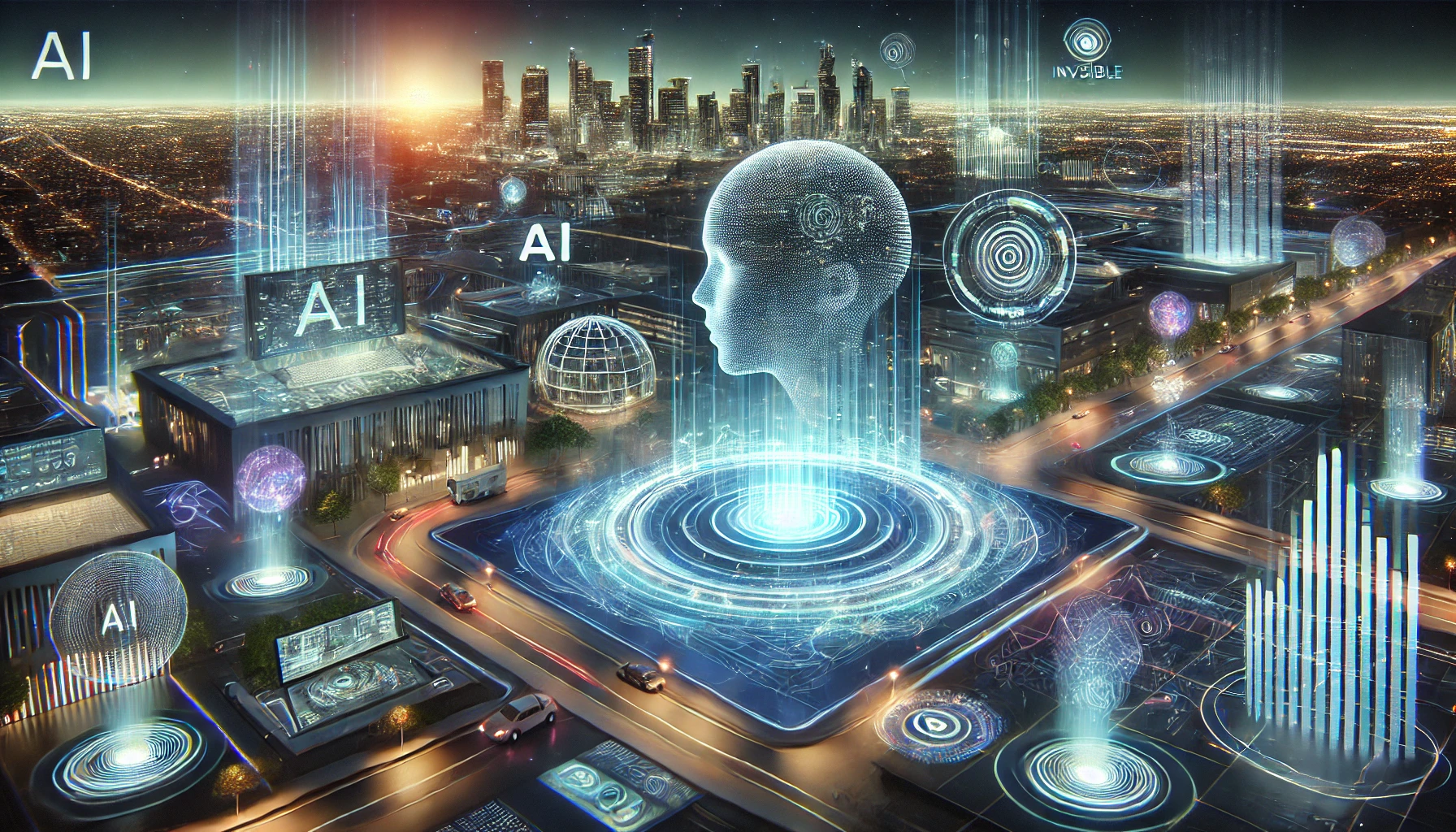Ambient Invisible Intelligence The Future of Seamless Technology Integration
Ambient Invisible Intelligence (AII) represents the next frontier in technology, where digital environments anticipate and respond to human needs without explicit commands. This article delves into the essence of AII, its foundational technologies, and its transformative potential across various sectors. From smart homes to urban infrastructures, discover how AII is redefining interaction paradigms, making technology an invisible yet omnipresent ally in our daily lives.
The Genesis of Ambient Invisible Intelligence
The concept of Ambient Invisible Intelligence (AII) didn’t emerge in isolation—it grew from decades of interdisciplinary research, blending ideas from computer science, human-computer interaction, and cognitive psychology. Its roots trace back to the late 1990s, when ambient intelligence (AmI) was first proposed by researchers at Philips and the European Commission’s ISTAG group. They envisioned environments where technology would be embedded, context-aware, and anticipatory, fading into the background while enhancing human life.
AII evolved this vision further by emphasizing invisibility—not just in physical form but in cognitive load. Pioneers like Mark Weiser, often called the father of ubiquitous computing, laid the groundwork with his seminal 1991 paper, The Computer for the 21st Century. He imagined a world where technology would weave itself into the fabric of everyday life, becoming indistinguishable from it. Weiser’s ideas were radical at the time, but they set the stage for AII by shifting focus from devices to experiences.
Later, advancements in AI, IoT, and sensor networks transformed these theories into tangible possibilities. Researchers like Hiroshi Ishii at MIT’s Media Lab explored tangible and ambient interfaces, while companies like Google and Apple experimented with context-aware systems. The rise of machine learning enabled systems to learn and adapt without explicit programming, a cornerstone of AII’s seamless integration.
Today, AII represents the culmination of these efforts—a paradigm where intelligence is omnipresent yet imperceptible, anticipating needs before they’re voiced. Unlike traditional AmI, which still required some user interaction, AII operates silently, leveraging real-time data and predictive analytics to blend into human behavior. This shift didn’t happen overnight; it was the result of relentless innovation by visionaries who saw technology not as a tool, but as an invisible partner in human existence.
Core Technologies Powering AII
At the heart of Ambient Invisible Intelligence (AII) lies a sophisticated interplay of cutting-edge technologies that work in harmony to create seamless, context-aware experiences. These core technologies—ranging from the Internet of Things (IoT) to artificial intelligence (AI), sensor networks, and nanotechnology—form the backbone of AII, enabling it to operate unobtrusively while deeply understanding and adapting to human needs.
The IoT serves as the connective tissue of AII, linking devices, environments, and users into a unified ecosystem. Smart sensors embedded in everyday objects collect real-time data, from temperature and motion to biometric signals, feeding a continuous stream of contextual information. These sensor networks are becoming increasingly granular, with advancements in miniaturization and energy efficiency allowing them to blend into surroundings without disruption.
AI and machine learning act as the brain of AII, processing vast datasets to predict behaviors, optimize responses, and personalize interactions. Edge computing ensures low-latency decision-making, enabling AII to react instantaneously without relying on distant cloud servers. Meanwhile, nanotechnology pushes the boundaries of invisibility, embedding microscopic computing and sensing capabilities into materials, fabrics, and even biological systems.
The true magic of AII emerges from the integration of these technologies. For instance, a smart home doesn’t just adjust lighting based on motion—it learns preferences, anticipates needs, and responds to subtle cues like heart rate or voice tone, all while remaining imperceptible. This seamless orchestration is what transforms discrete innovations into an ambient, intelligent fabric woven into the background of our lives. As these technologies evolve, AII will become even more intuitive, dissolving the line between the digital and physical worlds.
AII in Everyday Life
Ambient Invisible Intelligence (AII) is quietly revolutionizing daily life by embedding itself into the fabric of our routines, often without us even noticing. In smart homes, AII orchestrates an ecosystem where devices communicate seamlessly to anticipate needs. Lights adjust based on natural light levels and occupancy, thermostats learn preferences over time, and refrigerators monitor food supplies to suggest grocery lists—all without explicit commands. These systems leverage sensor networks and IoT connectivity, as discussed earlier, but their true power lies in their ability to fade into the background, creating an environment that feels intuitively responsive.
Wearables exemplify AII’s personal touch. Advanced biosensors track vitals, sleep patterns, and activity levels, offering real-time insights while remaining unobtrusive. A smartwatch might detect irregular heart rhythms and prompt a check-up or adjust workout recommendations based on fatigue levels. The device doesn’t just collect data; it interprets and acts, blending into the user’s lifestyle as a silent health companion.
Personal assistants, powered by AII, go beyond voice commands. They predict needs by analyzing context—suggesting a faster route when traffic builds, drafting emails based on past communication styles, or even ordering coffee when a morning meeting is scheduled. Unlike traditional AI, these systems don’t wait for prompts; they proactively intervene, refining their actions through continuous learning.
The magic of AII lies in its invisibility. By removing friction from interactions, it allows technology to serve as an extension of human intent rather than a tool requiring constant attention. As we’ll explore next, this adaptability hinges on AI and machine learning, which enable systems to evolve alongside users, making every interaction feel effortlessly natural.
The Role of AI and Machine Learning
At the core of Ambient Invisible Intelligence (AII) lies the seamless orchestration of artificial intelligence (AI) and machine learning (ML), enabling systems to operate intuitively without explicit user input. Unlike traditional AI, which often requires direct interaction, AII leverages advanced algorithms to blend into the background, learning from context and behavior to deliver adaptive, predictive, and personalized experiences.
AI and ML empower AII systems to process vast amounts of data in real time, identifying patterns that humans might overlook. For instance, a smart home equipped with AII doesn’t just respond to voice commands—it anticipates needs by analyzing routines, environmental conditions, and even subtle cues like changes in lighting or temperature preferences. Similarly, wearables go beyond tracking steps; they predict fatigue or stress levels by correlating biometric data with historical behavior, adjusting notifications or suggesting breaks proactively.
The key to this adaptability is reinforcement learning, where systems continuously refine their models based on feedback loops. For example, an AII-powered personal assistant doesn’t just follow preset rules—it evolves, learning from user corrections, contextual shifts, and even emotional tones to improve its responses over time.
However, this intelligence isn’t monolithic. Federated learning allows AII systems to train collaboratively without centralizing sensitive data, preserving privacy while enhancing accuracy. Edge computing further decentralizes processing, enabling real-time decisions without latency. Together, these technologies ensure AII remains unobtrusive yet indispensable, quietly shaping interactions between users and their environments.
As AII becomes more pervasive, the line between digital and physical worlds blurs, setting the stage for deeper discussions on how to safeguard privacy and security in this invisible yet omnipresent ecosystem.
Privacy and Security in an AII World
As artificial intelligence and machine learning enable ambient invisible intelligence (AII) to blend seamlessly into our surroundings, concerns about privacy and security become paramount. Unlike traditional systems, AII operates continuously in the background, collecting and processing vast amounts of data—often without explicit user interaction. This raises critical questions: How do we protect sensitive information when intelligence is omnipresent yet unseen?
One major challenge is data minimization. AII systems, by design, thrive on context-awareness, requiring access to personal, behavioral, and environmental data. However, unchecked data collection risks exploitation or breaches. Solutions like edge computing and federated learning can help by processing data locally, reducing exposure to centralized vulnerabilities. Additionally, differential privacy techniques can anonymize datasets, ensuring insights are derived without compromising individual identities.
Another concern is consent and transparency. Traditional permissions models are ill-suited for AII, where interactions are passive and continuous. Innovations such as adaptive consent frameworks—where users set granular, context-aware preferences—can empower individuals without disrupting seamless experiences. Meanwhile, zero-trust architectures can enforce strict access controls, verifying every request as if it originates from an untrusted network.
Security threats also evolve with AII. Adversarial attacks could manipulate ambient systems, leading to misinformation or unauthorized control. Robust AI explainability and real-time anomaly detection are essential to identify and mitigate such risks. Regulatory frameworks, like the EU’s AI Act, must adapt to hold AII developers accountable for ethical data practices.
Ultimately, the success of AII hinges on balancing invisibility with trust. As these systems redefine workplaces in the next chapter, ensuring privacy and security will be foundational to their acceptance and effectiveness.
AII and the Future of Work
Ambient Invisible Intelligence (AII) is quietly revolutionizing the workplace, transforming how humans and machines collaborate while enhancing productivity in ways previously unimaginable. Unlike traditional automation, which often requires explicit input, AII operates seamlessly in the background, anticipating needs and optimizing workflows without disrupting human focus. By integrating sensors, AI, and IoT, AII creates an environment where technology adapts to workers rather than the other way around.
One of the most profound impacts of AII is its ability to reduce cognitive load. Intelligent systems analyze work patterns, prioritize tasks, and even suggest optimal break times to maintain peak performance. For example, AII-equipped meeting rooms can automatically adjust lighting, temperature, and audio settings based on participant preferences and real-time engagement metrics. Similarly, AI-driven assistants can draft emails, summarize documents, or flag critical information—freeing employees to focus on creative and strategic tasks.
Human-machine collaboration is also being redefined. AII enables context-aware computing, where machines understand not just commands but intent. A factory worker wearing smart glasses might receive real-time safety alerts or step-by-step guidance without manually querying a system. In knowledge work, AII can surface relevant data or connect colleagues with complementary expertise, fostering spontaneous innovation.
However, this shift raises questions about workforce adaptation. While AII enhances efficiency, it demands new skills—particularly in interpreting AI-generated insights and managing hybrid human-AI workflows. Organizations must invest in continuous learning to ensure employees thrive alongside these invisible collaborators.
As workplaces evolve, AII’s role will expand beyond efficiency, shaping cultures of intuitive productivity where technology fades into the background, leaving humans to focus on what they do best—thinking, creating, and connecting. The next frontier lies in urban spaces, where AII’s potential to streamline complex systems mirrors its transformative impact on work.
Urban Spaces Transformed by AII
Urban spaces are undergoing a silent revolution, powered by Ambient Invisible Intelligence (AII). Unlike traditional smart city technologies that rely on visible interfaces, AII operates seamlessly in the background, orchestrating urban systems without disrupting daily life. From optimizing traffic flows to enhancing public safety, AII is redefining how cities function, making them more responsive, efficient, and livable.
At the heart of this transformation is real-time data synthesis. AII systems process vast amounts of information from sensors, cameras, and IoT devices, analyzing patterns to predict and mitigate urban challenges. For example, traffic lights adjust dynamically to reduce congestion, while waste management systems optimize collection routes based on fill-level sensors. These interventions happen invisibly, eliminating the need for manual oversight and reducing human error.
Public services also benefit from AII’s unobtrusive presence. Streetlights dim when no one is around, saving energy without residents noticing. Air quality monitors trigger ventilation systems in public transport before pollution levels rise, ensuring healthier commutes. Even emergency response is enhanced, as AII can detect accidents or hazards through sound and motion analysis, dispatching help faster than human operators.
However, the integration of AII into urban life raises questions about balance. While it improves efficiency, its invisibility means citizens may not always be aware of how their data is used or how decisions are made. This sets the stage for the next discussion on ethics, where transparency and autonomy must be addressed to ensure AII serves everyone equitably. The promise of smarter cities is undeniable, but it must be built on trust as much as technology.
Ethical Considerations of Invisible Technology
As Ambient Invisible Intelligence (AII) becomes deeply embedded in urban environments, ethical concerns emerge that demand careful scrutiny. The seamless integration of AII into daily life raises fundamental questions about autonomy, surveillance, and equity. Unlike visible technologies, AII operates in the background, often without explicit user consent, blurring the lines between convenience and intrusion.
One pressing issue is the erosion of individual autonomy. AII systems, designed to anticipate needs and automate decisions, may subtly influence behavior without users realizing it. For example, smart traffic management might reroute drivers based on real-time data, but who determines the priorities—efficiency, safety, or commercial interests? The lack of transparency in algorithmic decision-making risks reducing human agency, as choices are increasingly shaped by unseen forces.
Surveillance is another critical concern. AII relies on vast data streams from sensors, cameras, and IoT devices, creating an omnipresent monitoring network. While this enables smarter cities, it also normalizes constant observation. The line between public safety and privacy invasion becomes precarious, especially when data is repurposed for profiling or predictive policing. Without robust safeguards, AII could enable authoritarian oversight under the guise of efficiency.
The digital divide further complicates AII’s ethical landscape. As urban spaces adopt these technologies, marginalized communities risk exclusion due to unequal access or biased algorithms. If AII-driven services prioritize affluent areas, disparities in healthcare, transportation, and safety could widen. Ethical AII deployment must address these inequities, ensuring inclusivity rather than exacerbating existing divides.
Balancing innovation with ethical responsibility is paramount. Without deliberate governance, AII’s invisibility could mask its societal impacts, leaving critical questions unanswered until it’s too late. The next chapter explores the challenges in adopting AII, but its ethical dilemmas must remain central to the conversation.
Challenges in AII Adoption
The widespread adoption of Ambient Invisible Intelligence (AII) faces significant technical, societal, and economic challenges that must be addressed to realize its seamless integration. Technical hurdles include the need for robust, low-latency infrastructure capable of processing vast amounts of data in real time. Edge computing and 5G networks are promising solutions, but interoperability between diverse IoT devices remains a barrier. Standardized protocols and adaptive AI models will be crucial to ensure seamless communication across heterogeneous systems.
Societal resistance stems from a lack of trust in invisible systems, exacerbated by concerns over privacy and autonomy—topics explored in the previous chapter. Unlike visible technology, AII operates without explicit user interaction, making transparency difficult. Educating users about its benefits while ensuring opt-out mechanisms could mitigate skepticism. Additionally, the risk of digital exclusion looms large, as marginalized communities may lack access to the necessary infrastructure, deepening existing inequalities. Policymakers must prioritize inclusive design and equitable deployment.
Economic constraints also hinder AII adoption. The high costs of developing and maintaining pervasive intelligent environments deter investment, particularly for small businesses. Scalability is another issue—while large corporations can afford experimentation, smaller entities struggle. Public-private partnerships and modular, cost-effective AII solutions could democratize access. Furthermore, the absence of clear monetization models for invisible services complicates ROI calculations, requiring innovative business strategies.
Overcoming these barriers demands a multidisciplinary approach, blending technological innovation with ethical foresight and economic pragmatism. As we look ahead to the next chapter, which envisions AII’s future, addressing these challenges will be pivotal in shaping a world where digital and physical realities harmoniously coexist.
Envisioning the Future with AII
As we move beyond the challenges of adoption, the long-term evolution of Ambient Invisible Intelligence (AII) promises to redefine the boundaries between the digital and physical worlds. Imagine a future where AII operates not just as a passive facilitator but as an intuitive extension of human cognition, anticipating needs before they arise and seamlessly integrating into every facet of daily life. The convergence of advanced AI, ubiquitous computing, and bio-interfaces could create an ecosystem where technology fades into the background, leaving only its benefits visible.
One transformative possibility lies in context-aware environments. Spaces—homes, offices, cities—will dynamically adapt to individual preferences, moods, and physiological states. For instance, lighting, temperature, and even acoustics could shift imperceptibly to optimize productivity or relaxation, guided by real-time biometric feedback. Beyond convenience, this could revolutionize healthcare, with AII systems detecting early signs of illness through subtle behavioral or physiological changes, enabling proactive interventions.
Another frontier is the fusion of AII with augmented reality (AR) and the Internet of Things (IoT). Instead of clunky wearables or intrusive notifications, information will manifest as a natural part of the physical world—think of virtual assistants that appear as holograms only when needed or digital overlays that enhance reality without distraction. The line between “online” and “offline” will dissolve, creating a continuous, augmented existence.
Ethical and philosophical questions will emerge as AII becomes more ingrained. Will humans retain agency in decision-making, or will algorithms subtly steer behavior? How do we preserve privacy in a world where intelligence is ambient yet invisible? These dilemmas will shape the next phase of AII’s evolution, demanding a balance between innovation and human-centric design. The future of AII isn’t just about smarter technology—it’s about reimagining what it means to be human in a seamlessly interconnected world.

Conclusions
Ambient Invisible Intelligence stands at the confluence of innovation and practicality, offering a glimpse into a future where technology fades into the background yet enhances every aspect of our lives. As we navigate the challenges and opportunities it presents, AII promises to redefine our interaction with the digital world, making it more intuitive, efficient, and harmonious. The journey towards this invisible future is both exciting and imperative.



